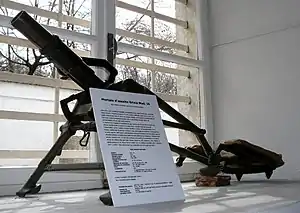Brixia Model 35
The Brixia Model 35 was an Italian small-sized, rapid firing light mortar of World War II.
| Brixia Model 35 Mortar | |
|---|---|
 | |
| Type | Infantry mortar |
| Place of origin | Kingdom of Italy |
| Service history | |
| In service | 3 October 1935 – c. January 1950 |
| Used by | Kingdom of Italy |
| Wars | Second Italo-Ethiopian War spanish civil war World War II |
| Production history | |
| Designed | 1935 |
| Produced | 1935 |
| Specifications | |
| Mass | 15.5 kg (34 lb) |
| Barrel length | 26 cm (10 in) L/5.4 |
| Crew | 2[1] |
| Shell | 465 g (1 lb) |
| Caliber | 45 mm (1.8 in) |
| Elevation | +10° to +90° |
| Traverse | 20°[1] |
| Rate of fire | 8-10 rpm[1] |
| Muzzle velocity | 83 m/s (270 ft/s) |
| Maximum firing range | 530 m (580 yd)[1] |
Description
.jpg.webp)
The Brixia light mortar is a 45 mm calibre light mortar mounted on a legged base and designed for operation by two crew.[2] The rear legs are fitted with a pad for the gunner to lay forward on behind the mortar, or sit upon when the situation allowed. A lever allowed for operating the breech and firing the weapon, while ammunition was fed in by the loader. Well trained teams could reach up to 18 rounds per minute, although operational rate of fire was less intense to avoid damage to the firing tube. The Brixia mortar differed from comparable World War II weapons in that it was trigger fired with the help of separate ignition cartridges to be fed into a special magazine, making the weapon more similar to modern cannon-mortars than conventional parabolic grenade launchers of the time.
At tactical level, an infantry battalion had two platoons each of 9 Brixia mortars assigned.[3] Each Brixia mortar platoon was divided in three squads with three mortars each, which were distributed to the companies. The heavier 81mm mortar was assigned to the heavy weapons company of the regiment.[3]
The Brixia was a complicated weapon but could lay down very precise and intense curtains of fire. This was offset by the shells, which fragmented poorly and, due to the limited calibre, had a very light and low-yield warhead.[1] The weapon served on every front where Italian troops were involved (North Africa, Balkans, East Africa, Southern Russia, France) and was also employed during defence of the homeland against invading allied troops and during clashes between RSI formations and Italian partisans, on both sides, due to many Italian partisans having a former military background it was one of the few support weapons which could be found in the hands of the local Resistance. Mortars used by the German units fighting alongside the Italians were given the designation 4.5 cm GrW 176(i).[4]
Users
.svg.png.webp) Nazi Germany
Nazi Germany.svg.png.webp) Kingdom of Greece: captured from the Italians[5]
Kingdom of Greece: captured from the Italians[5]_crowned.svg.png.webp) Kingdom of Italy
Kingdom of Italy Italian Social Republic
Italian Social Republic.svg.png.webp) Yugoslav Partisans[6]
Yugoslav Partisans[6]
See also
- Tromboncino M28 grenade launcher, a combined carbine and rifle grenade launcher, used unsuccessfully prior to the Model 35
- List of artillery
References
- Chamberlain, Peter (1975). Mortars and rockets. Gander, Terry. New York: Arco Pub. Co. p. 11. ISBN 0668038179. OCLC 2067459.
- Norris, John (11 December 2002). Infantry Mortars of World War II. New Vanguard 54. Osprey Publishing. pp. 34–35. ISBN 9781841764146.CS1 maint: ref=harv (link)
- Athanassiou 2017, p. 34.
- Bishop, Chris, ed. (2002). "45/5 modello 35 'Brixia'". The Encyclopedia of Weapons of World War II. Sterling Publishing Company. p. 196. ISBN 978-1-58663-762-0.
- Athanassiou 2017, p. 19.
- Vukšić, Velimir (July 2003). Tito's partisans 1941–45. Warrior 73. Osprey Publishing. p. 25. ISBN 978-1-84176-675-1.
- Athanassiou, Phoebus (2017). Armies of the Greek-Italian War 1940-41. Men-at-Arms 514. ISBN 978-1-4728-1917-8.CS1 maint: ref=harv (link)
External links
| Wikimedia Commons has media related to Brixia Model 35. |